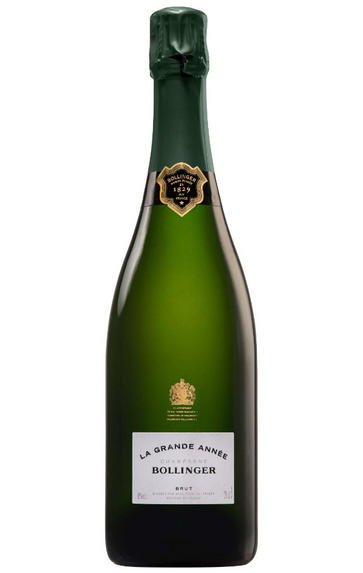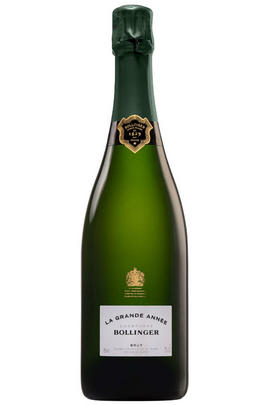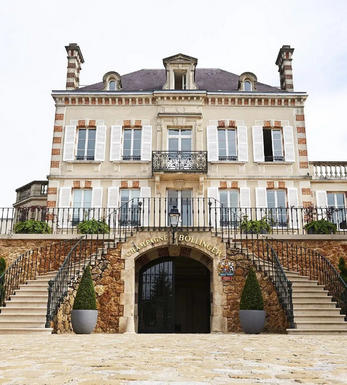
2005 Champagne Bollinger, La Grande Année, Brut

Critics reviews
William Kelley - 29/03/2019
Richard Juhlin - Champagneclub.com
About this WINE

Bollinger
The Champagne House of Bollinger was established in 1829 by Jacques Bollinger and Paul Renaudin. Over the years the vineyard holdings have been steadily increased with the largest expansion taking place under the stewardship of the legendary Mme Lily Bollinger. She ran the company between 1941 and 1977 and today it is managed by her great-nephew, Ghislain de Montgolfier.
Bollinger has a reputation for producing muscular champagnes with body, depth and power, and is today considered one of the "Great" Champagne houses.
70% of the grapes come from the firm's own vineyards. 80% of the harvest is barrel-fermented with the wines being kept on their yeast lees for an extended period of time (in the case of the RD, around 10 years).
Bollinger produces classic, complex, Pinot-Noir dominated champagnes with the ability to age gracefully for many years.

Brut Champagne
Brut denotes a dry style of Champagne (less than 15 grams per litre). Most Champagne is non-vintage, produced from a blend from different years. The non-vintage blend is always based predominately on wines made from the current harvest, enriched with aged wines (their proportion and age varies by brand) from earlier harvests, which impart an additional level of complexity to the end wine. Champagnes from a single vintage are labelled with the year reference and with the description Millésimé.
Non-vintage Champagnes can improve with short-term ageing (typically two to three years), while vintages can develop over much longer periods (five to 30 years). The most exquisite and often top-priced expression of a house’s style is referred to as Prestige Cuvée. Famous examples include Louis Roederer's Cristal, Moët & Chandon's Dom Pérignon, and Pol Roger's Cuvée Sir Winston Churchill.
Recommended Producers : Krug, Billecart Salmon, Pol Roger, Bollinger, Salon, Gosset, Pierre Péters, Ruinart

Champagne blend
Which grapes are included in the blend, and their proportion, is one of the key factors determining the style of most Champagnes. Three grapes are used - Pinot Noir, Chardonnay and Pinot Meunier.
26% of vineyards in Champagne are planted with Chardonnay and it performs best on the Côtes des Blancs and on the chalk slopes south of Epernay. It is relatively simple to grow, although it buds early and thus is susceptible to spring frosts. It produces lighter, fresher wines than those from Burgundy and gives finesse, fruit and elegance to the final blend. It is the sole grape in Blancs de Blancs, which are some of the richest long-lived Champagnes produced.
Pinot Noir accounts for nearly 40% of the plantings in Champagne and lies at the heart of most blends - it gives Champagne its body, structure, strength and grip. It is planted across Champagne and particularly so in the southern Aube district.
The final component is Pinot Meunier and this constitutes nearly 35% of the plantings. Its durability and resistance to spring frosts make the Marne Valley, a notorious frost pocket, its natural home. It ripens well in poor years and produces a soft, fruity style of wine that is ideal for blending with the more assertive flavours of Pinot Noir. Producers allege that Pinot Meunier lacks ageing potential, but this does not deter Krug from including around 15% of it in their final blends.


Buying options
Add to wishlist
Description
Ready to drink now, there is an abundance of ripe and generous flavour on the nose, with quince, caramelised apple and hazelnut standing out. The palate is broad, with a creamy texture from the oak fermentation and fine, delicate mousse. There is a note of honey on the long finish. One to enjoy immediately whilst waiting for the 2002s.
Fergus Stewart - Private Account Manager
La Grande Année is the ultimate expression of the Bollinger house style; rich and full - one of the world’s great Champagnes. The Champagne House of Bollinger was established in 1829 and rose to prominence under the stewardship of the legendary Mme Lily Bollinger. Still family owned, this is a Champagne house of world renown. In the best vintages, they produce La Grande Année, their “Prestige Cuvée”. 95% of the fruit is from Grand Cru sites, the remaining 5% from the finest Premier Crus; first fermentation is in 100% old oak barrels, followed by 6 years ageing on its lees with manual riddling prior to disgorgement. These are classic and complex Pinot Noir dominated Champagnes (70% Pinot Noir, 30% Chardonnay), powerful yet refined with the ability to age beautifully. Bollinger’s Grande Année style has become more precise and focused in recent years; this has been achieved with consummate skill as both the perfectionist philosophy and, not unrelated, the methodology of vinification, remain unchanged, the latter employing fermentation in old wood and then 72 months en tirage resting under natural cork on its yeast. Old-style Bollinger was indulgent, autumnal and entirely delicious; new-style Bollinger maintains as axiomatic at least two of these descriptors. The emphasis on freshness is evidenced from the lighter colour, the pinpoint bubbles and a memorable palate which recalls white chocolate, soft honey and yellow fruit. The 70 % Pinot Noir lends intimations of the savoury and playful red fruit rejoinders; the ensemble defers to a vintage which commands respect and, in such an approachable manifestation, affection . An exceptional piece of work.
Simon Field MW – Wine Buyer
wine at a glance
Delivery and quality guarantee